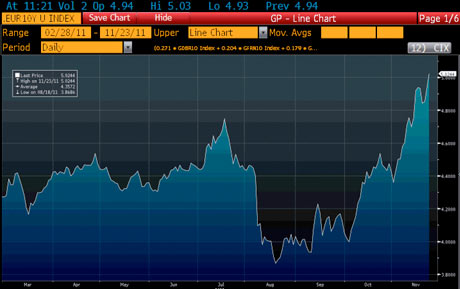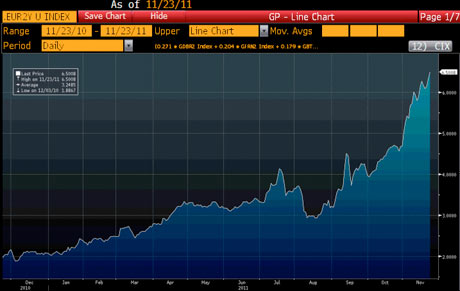Here are a couple of eyecatching graphs pulled from Bloomberg by analysts at bond manager M&G Investments and French bank BNP Paribas. They show eurozone government bond yield weighted by each country's GDP. So think of the charts as a rough approximation of the movement in borrowing costs for an imaginary United States of Europe. Up, up and away since the start of October is the quick summary.
Read It
The Apocalypse Trade
In particular, market expectations seem to assume that the ECB will remain utterly indifferent to its responsibilities. The German breakeven rate, an implicit forecast of inflation over the next 5 years, is just 1 percent. That’s a disaster level, implying severe deflation in the debtor nations — or, more likely, a euro breakup.
All American Investor
CNBC Bonus Bucks Answers for Thanksgiving Day
Everyone Knew They Were Making Liar Loans (Mortgages)
More stress ahead for euro zone banks
Signs of euro zone money market stress grew on Thursday, and the move could accelerate before the end of the year despite a Reuters report that the European Central Bank is mulling ultra-long loans to banks to fight the crisis.
Euro 'Garlic Belt' Condemned to Deflation
The euro zone's "garlic belt" states (Greece, Italy, Portugal and Spain) will have to endure deflation to catch up in competitiveness with the other, "butter belt" members, according to a report by research firm Smithers & Co.
Contagion Is 'Spilling' Into Germany, Says Major
Steven Major, global head of fixed-income research at HSBC Holdings Plc, talks about Germany's sovereign-debt contagion risk and proposals for a common euro-area bond. He speaks with Bloomberg's Manus Cranny in London. (Source: Bloomberg)
Original content Bob DeMarco, All American Investor


No comments:
Post a Comment